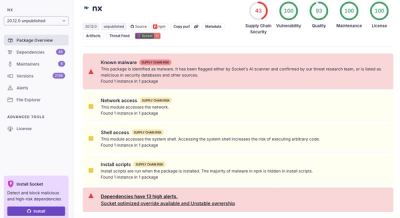
Security News
/Research
Wallet-Draining npm Package Impersonates Nodemailer to Hijack Crypto Transactions
Malicious npm package impersonates Nodemailer and drains wallets by hijacking crypto transactions across multiple blockchains.
@fireact/core
Advanced tools
Core components and utilities for Fireact applications.
npm install @fireact/core
npm install firebase react-router-dom i18next react-i18next @headlessui/react @heroicons/react tailwindcss i18next-browser-languagedetector
npx tailwindcss init
Update your tailwind.config.js:
/** @type {import('tailwindcss').Config} */
module.exports = {
content: [
"./src/**/*.{js,jsx,ts,tsx}",
"./node_modules/@fireact/core/dist/**/*.{js,mjs}" // Add this line
],
theme: {
extend: {},
},
plugins: [],
}
Add Tailwind directives to your CSS:
@tailwind base;
@tailwind components;
@tailwind utilities;
{
"firebase": {
"apiKey": "your-api-key",
"authDomain": "your-auth-domain",
"projectId": "your-project-id",
"storageBucket": "your-storage-bucket",
"messagingSenderId": "your-messaging-sender-id",
"appId": "your-app-id"
},
"socialLogin": {
"google": true,
"microsoft": false,
"facebook": false,
"apple": false,
"github": false,
"twitter": false,
"yahoo": false
},
"pages": {
"home": "/",
"dashboard": "/dashboard",
"profile": "/profile",
"editName": "/edit-name",
"editEmail": "/edit-email",
"changePassword": "/change-password",
"deleteAccount": "/delete-account",
"signIn": "/signin",
"signUp": "/signup",
"resetPassword": "/reset-password"
}
}
To enable or disable social login providers:
Set the corresponding provider to true in the socialLogin section of your config.json
Configure the provider in your Firebase Console:
Create an App.tsx file in your project:
import { BrowserRouter as Router, Routes, Route, Navigate } from 'react-router-dom';
import {
AuthProvider,
ConfigProvider,
LoadingProvider,
PublicLayout,
AuthenticatedLayout,
SignIn,
SignUp,
ResetPassword,
Dashboard,
Profile,
EditName,
EditEmail,
ChangePassword,
DeleteAccount,
DesktopMenuItems,
MobileMenuItems,
Logo
} from '@fireact/core';
import config from './config.json';
import i18n from 'i18next';
import { initReactI18next } from 'react-i18next';
import LanguageDetector from 'i18next-browser-languagedetector';
import en from './i18n/locales/en';
import zh from './i18n/locales/zh';
// Initialize i18next
i18n
.use(LanguageDetector)
.use(initReactI18next)
.init({
resources: {
en: {
translation: en
},
zh: {
translation: zh
}
},
fallbackLng: 'en',
interpolation: {
escapeValue: false
}
});
function App() {
return (
<Router>
<ConfigProvider config={config}>
<AuthProvider>
<LoadingProvider>
<Routes>
<Route element={
<AuthenticatedLayout
desktopMenuItems={<DesktopMenuItems />}
mobileMenuItems={<MobileMenuItems />}
logo={<Logo className="w-10 h-10" />}
/>
}>
<Route path={config.pages.home} element={<Navigate to={config.pages.dashboard} />} />
<Route path={config.pages.dashboard} element={<Dashboard />} />
<Route path={config.pages.profile} element={<Profile />} />
<Route path={config.pages.editName} element={<EditName />} />
<Route path={config.pages.editEmail} element={<EditEmail />} />
<Route path={config.pages.changePassword} element={<ChangePassword />} />
<Route path={config.pages.deleteAccount} element={<DeleteAccount />} />
</Route>
<Route element={<PublicLayout logo={<Logo className="w-20 h-20" />} />}>
<Route path={config.pages.signIn} element={<SignIn />} />
<Route path={config.pages.signUp} element={<SignUp />} />
<Route path={config.pages.resetPassword} element={<ResetPassword />} />
</Route>
</Routes>
</LoadingProvider>
</AuthProvider>
</ConfigProvider>
</Router>
);
}
export default App;
Create a directory structure in your project:
src/
i18n/
locales/
en.ts
zh.ts
Download the language files from: https://github.com/chaoming/fireact/tree/main/src/i18n/locales
Note: The ConfigProvider will automatically initialize Firebase using the configuration from config.json. You don't need to initialize Firebase separately.
@tailwind base;
@tailwind components;
@tailwind utilities;
import React from 'react';
import ReactDOM from 'react-dom/client';
import App from './App';
import './index.css';
ReactDOM.createRoot(document.getElementById('root')!).render(
<React.StrictMode>
<App />
</React.StrictMode>
);
npm install -g firebase-tools
firebase login
firebase init
During the initialization process:
npm run build
firebase deploy
Your app will be deployed and accessible at https://your-project-id.web.app and https://your-project-id.firebaseapp.com
MIT
FAQs
Core components and utilities for Fireact applications
The npm package @fireact/core receives a total of 0 weekly downloads. As such, @fireact/core popularity was classified as not popular.
We found that @fireact/core demonstrated a healthy version release cadence and project activity because the last version was released less than a year ago. It has 0 open source maintainers collaborating on the project.
Did you know?

Socket for GitHub automatically highlights issues in each pull request and monitors the health of all your open source dependencies. Discover the contents of your packages and block harmful activity before you install or update your dependencies.

Security News
/Research
Malicious npm package impersonates Nodemailer and drains wallets by hijacking crypto transactions across multiple blockchains.

Security News
This episode explores the hard problem of reachability analysis, from static analysis limits to handling dynamic languages and massive dependency trees.

Security News
/Research
Malicious Nx npm versions stole secrets and wallet info using AI CLI tools; Socket’s AI scanner detected the supply chain attack and flagged the malware.